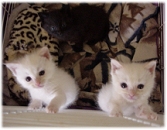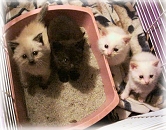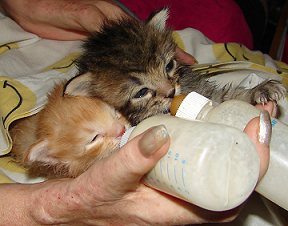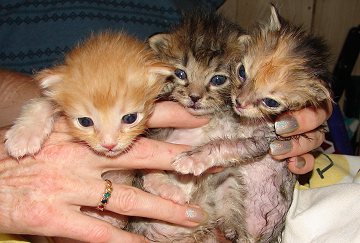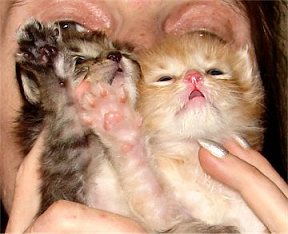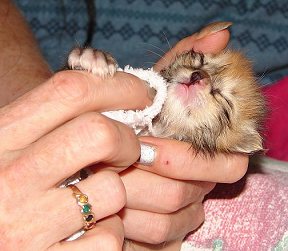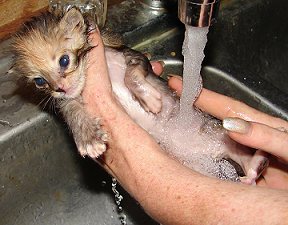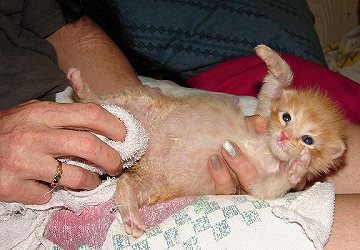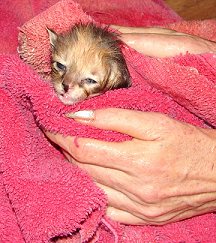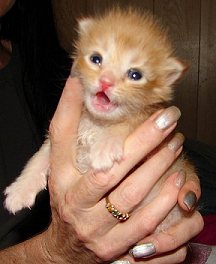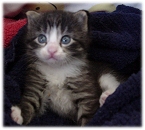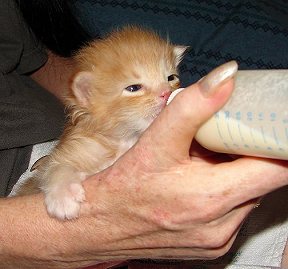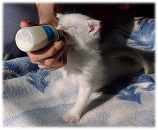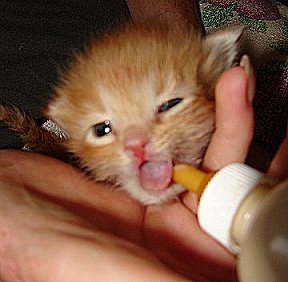| Kitten Housing | |||||
The "nesting box" needs to be a safe, clean, warm, dry place for kittens to get the tremendous amount of sleep they need to grow and develop in the critical first few weeks.
 Entirely Pets The nest box does not have to be elaborate, and using a cardboard box works just fine!! Warmth is going to be especially vital in the first two weeks of a kitten's life, as they are not able to shiver, and you cannot tell when they are cold.
When using the heating pad, be sure to keep it on the lowest setting, and wrap it well with towels and waterproof pads. Set the heating pad BELOW the box itself, to one side or corner under the nest box, so that the kittens can move to a cooler area inside their box if it becomes too warm for them. You will want the nest box to be in a quiet, private, draft-free location, with the sides of the box high enough to keep the kittens in, and the overall box size large enough to allow for some exercise. Be sure that the kittens can not get stuck under some pads in the sides or corners of the box, or that they cannot climb under the layers of towels and get directly on to the heating pad (which is why we recommend placing the pad itself under, not in, the box). | |||||
|
 Petco | |||||
Oct 26, 2005
Kitten Housing
Squirrel Release Time
Missy, the partially paralyzed squirrel will have to stay at the Rainbow Wildlife Rescue. I will build her a nice big enclosure outside, so she can still be a squirrel. Releasing her is not possible due to her paralyzed left hind leg and tail.
Here is a picture of Missy and 2 of the older squirrels:

Oct 21, 2005
Litter-box Training
| Litter-box Training | |||||
Cats don't need to be trained to use a litter box - they just do it. By understanding why they prefer to eliminate in a litter box will help their human owners not to make any mistakes in having and maintaining the "cat box". It is a cat's basic instinct (even big cats) to eliminate away from their food and sleeping area and to bury the waste in order to hide their position from other animals and protect their nests and young. Most kittens start using the litter-box at the age of 3-4 weeks on their own. At this young age you can show the kitten where to go and it might happen a bit faster:
 Paws Up Pet Supply Here are a few things to consider about the litter box:
| |||||
|
 Only Natural Pet Store | |||||
Oct 18, 2005
Socialize your Kitten
| Socialize your Kitten | ||
Socializing and PlayingThe first few weeks in a kitten's life are the most important ones in terms of socializing and bonding with a human, and should be treated as a very precious time in your relationship. This is the time for cuddling and holding, playing gently, and talking to your kitten. Properly handled, he will associate these happy times with you, dear human, and be a friend to you for life. Like clay in your hands, you can mold his personality, while at the same time, strengthening your own commitment to him to cherish him and care for him the rest of his life.
Kittens in their early weeks will play with almost anything. You may be tempted to buy a bunch of toys, but remember, their attention spans are much like those of children, and they might be just as happy playing with a crumpled up ball of paper as with a motorized mouse.
 Only Natural Pet Store One important caution at this age: don't let your kitten start to associate your hands with a play toy. Doing so can develop into bad habits of scratching and biting fingers. Hands are for holding, stroking and gentle hugs; toys are for rough play. Bond with a KittenHandling an unruly cat can sometimes be difficult, but by training him from kittenhood to be handled, you'll be able to groom, clip toenails, and examine him routinely with his full cooperation.
Tips:
 Petco More Tips: 1. These steps should take about five minutes per session. Start with one session per day, and add more as needed, depending on the kitten's tolerance for handling. 2. As with all other forms of training, don't make it an adversarial experience. When kitty gets tired, or if he's just having a bad day, give him a hug and gently put him down. You can always try again tomorrow. 3. As your kitten grows older, inspect him at least once a week. You can combine the inspection with his grooming session. Maximize your bond while improving his health and well-beingYou enjoy playing with your cat, or you wouldn't be reading this article. Interactive playing with cats is not only fun, but it provides valuable exercise for cats of all ages; just as important, it strengthens the feline-human bond, which is all-important to genuine cat lovers.
Kittens will play with anything. Just keep dangerous items like string, plastic bags, small ingestibles, and just about everything else away from the insatiable Mr. Kitten if you're not supervising him. Many kitten owners will tell you that the only thing known to mankind that can keep up with a kitten is…another kitten. You'll enjoy playing with him with interactive toys, but be aware that he should learn early-on that your hands are not toys. Ignore this advice, and you may learn to regret it when he grows up and develops full-sized teeth and claws. Why Playing
 Smart Cat Products How to PlayKeep a rotating array of toys on hand.
Afterwards, lots of praise and treats all around. Good times to quit the play session are: 1. After you've gone for 10-15 minutes and your cat has just scored a decisive victory. 2. You've tried for a few minutes to engage your cat in a play session, but he's just not into it right now. In both scenarios, give your cat some nice praise just for showing up. In the first case, make the victory a little sweeter with a nice treat. Tell him what a good hunter he is. | ||
Oct 14, 2005
How to Keep the Kitten Clean
| How to Keep the Kitten Clean | |||||
Each and every animal should be in pristine, beautiful coated condition, constantly. It’s certainly rougher when you have some sick kittens, but still they need to be perfectly clean as soon as you are done with them.
There are several crucial health concerns that need to be addressed.
 Only Natural Pet Store How to clean your kitten Brushing: Cats naturally groom themselves and can take offense when you try to help them. Bathing: Start bathing kittens early! Cats aren't really afraid of the water, but the noise running water makes! Once startled they learn to fear it. Start the first day you have the kitten. Dunk her feet into very shallow, very warm water. Leave the tap water running, so she gets used to the sound. Then immediately dry her feet and give her a special treat or bottle and attention. Do this for another day or 2 and then set her down in the water and let her stand in it for a few seconds, then pull her out and dry her feet always followed by the treat. Towards the end of the second week, you should be able to completely wash her, even under running tab water. All my kittens, without exception purr after they got a bath. Keep everything, water, soap, etc, out of her eyes and off her face. This will cause panic, and could irritate her eyes and most important, will scare her for good. | |||||
|
 Petco | |||||
Oct 12, 2005
How to help the Kitty to eliminate
| How to help the Kitty to eliminate | ||
The mother cat will stimulate her kitten's elimination by licking his anus and genital area with her rough tongue. You can emulate this process with a warm, rough washcloth. It may take a couple of feedings to see results, so don't despair if he doesn't defecate right away. Urinating may take a bit longer.
Normally, kittens will have a couple of firm, yellowish stools per day if they are being properly fed. Most kittens can control their own bowel movements at about 10 days old. The skin area is very delicate and may become raw or sore from your efforts. If this happens, apply a tiny dab of Preparation H ointment to the affected area after each stimulation. Keep in mind that your kitten will probably not have a bowel movement every feeding, and sometimes even skip a day. This should be fine as long as the kitten is growing, eating well, not showing any signs of distress, and urinating. Young kittens must be protected from disease!! ALWAYS wash your hands before and after handling the kittens, and ALWAYS clean and sterilize your bottles, nipples, brushes, or tube feeders in boiling water after each use!!
 Entirely Pets DIARRHEA/CONSTIPATION What does a loose and/or yellow stool mean? This would indicate a mild case of What does a loose and/or greenish color stool mean? This would be indicative that the food is moving too quickly through the kitten's system, and the bile is not being absorbed, and is probably attributed to moderate overfeeding. Cut the formula back with the Pedialyte or bottled water; in severe cases use 2 to 3 drops of Kaopectate every four hours until this problem clears up. What about stools that look like cottage cheese? Either the formula strength is too rich, there is severe overfeeding, or the kitten may have a bacterial infection. Check with the shelter manager who may recommend that you cut the formula in half with bottled water and/or Pedialyte liquid, and start the kitten on antibiotics. If the kitten is seriously dehydrated, fluids can be given under the skin. Constipated or straining kittens? In this case, you would want to increase the strength of the formula, and feed slightly smaller amounts, but feed more frequently. If the kitten has a swollen abdomen and hasn't passed a bowel movement in over a day, you may want to try mineral oil given by mouth (3 drops per ounce of body weight). Stool Color:
 Only Natural Pet Store Urine color:
| ||
Oct 11, 2005
Kitten's First Aid
| First Aid | ||||
First Aid Kit for Pet Owners: | ||||
| ||||
|
 Only Natural Pet Store The following are questions that you should ask and things to check before calling the veterinarian:
Remember that a frightened or painful animal could bite or scratch. Be prepared with a cloth or with a large, thick blanket or towel to restrain a small animal. Have a family member or neighbor assist in transport. Trauma: Make sure kitten is breathing. Reduce any bleeding with direct pressure. Arterial bleeding (spurting blood) may require a tourniquet. (Tourniquets can be dangerous if left on too long; transport immediately.) Secure kitten in a blanket or towel if possible to reduce movement. Transport to hospital immediately. Choking: Be very careful when attempting to clear airway; kitten will often bite if panicked. The Heimlich Maneuver may work if an item is lodged in windpipe. (Note: coughing and gagging are often confused with choking--a kitten which is truly choking will move little or no air at all, and his gum color will be gray or bluish. A kitten who experiences periodic episodes of "choking" may be gagging.) Transport to hospital immediately.
 Your Active Pet Poisoning: Call Poison Control (1-800-222-1222). DO NOT induce vomiting unless instructed to do so. If advised to induce vomiting, give Hydrogen Peroxide until desired result achieved. Some poisons are fatal over time; immediate treatment is crucial even if kitten does not appear sick. Bring the poison label with you if possible and transport to hospital. (Click here for a more complete index of toxic plants). Respiratory Distress: If kitten is gasping or breathing heavily, remove collars/leads and use minimal restraint during transport. Stay calm--kittens can sense and react to our stress. Transport to hospital immediately. Seizure: Make sure that kitten cannot hurt himself. DO NOT attempt to place anything in his mouth. If poisons such as snail bait have been used recently, bring box with you to the veterinarian. Bundle kitten in a blanket--get help to transport kitten in case seizures occur. Transport to hospital immediately. Straining to Urinate: Inability to urinate is life-threatening. There is no home aid. Transport to hospital immediately. Diabetic Insulin Crisis: Hypoglycemia (low blood sugar) can be characterized by weakness, disorientation, seizures. Place Karo Syrup® on gums and transport to hospital immediately. Nonproductive Vomiting or Retching: This is the most common sign of a life-threatening condition called "gastric dilitation and volvulus", or "torsion." There is no home aid. Transport to hospital immediately. Bleeding (Hemorrhaging): For bleeding wounds, apply direct pressure with a thick cloth. If blood soaks through, apply additional cloths (do not remove original dressing). If blood is spurting from wound (arterial bleeding), apply tourniquet above wound. (Tourniquets are only practical on limbs, and can be dangerous if left on long, so transport immediately.) If kitten is bleeding from rectum, mouth or other orifice, no home aid is recommended. In all cases, transport to hospital immediately. Heatstroke: Heatstroke is characterized by acute collapse, often following heavy activity in hot weather or confinement in a hot space such as a car. The kitten will pant heavily, and mucous membranes may be brick red. Give a cold water bath or drench with a hose and transport to hospital immediately. | ||||
Oct 10, 2005
First Things to Do with a New Kitten
| First Things to Do | ||
Always, always isolate a rescued cat or kitten from your pets for at least fourteen days and until it has been examined by your veterinarian and tested for lethal disease; even a tiny kitten can pack a killer virus or parasite. Make the kitten comfortable in a room that is frequently visited by you and that is separate from your other pets, and wash your hands with an antibacterial soap between visits to the new animal and your household. Consult with your veterinarian so that you are able to weigh the risks against the many blessings of taking in an orphan kitten. Determine the Kitten's Condition If the kitten is lethargic or cool to the touch, you may have a life-threatening emergency (such as exposure or distemper). Get the kittenon a heating pad or other primary heat source (see item 2) and get it to a veterinarian right away or consult an emergency veterinaryclinic.
 Only Natural Pet Store Do NOT feed a chilled newborn -- you will kill it. Instead, administer slightly warmed Pedialyte (an infant rehydrating fluid, available in any grocery or pharmacy), using an animal nurser, syringe, or dropper. (You can greatly extend the life of the Pedialyte by freezing it as ice cubes, bagging the cubes and storing them in your freezer, by the way.) Feed the kitten only when it is warmed and indicates it is hungry.
If the kitten seems over-warm and/or is breathing rapidly, it may be feverish or suffering from heat exhaustion or worse. Contact your vet or an emergency veterinary clinic immediately for advice if you can. To help lower the kitten's body temperature, try wiping it down with a cool, damp cloth; then administer Pedialyte. Get the kitten to a veterinarian as soon as possible. Warm the kitten A newborn kitten is not capable of generating or maintaining body warmth and must depend on its mother (and now you) to sustain warmth and life. Keeping a newborn orphan warm (even on a warm day) is a priority, more important initially than feeding (do NOT feed a chilled kitten, by the way -- you will kill it). Bundling up the kitten will do no good; it has no body heat of its own to retain. And putting the kitten near a space heater or other heating element is neither sufficient for the long-term nor safe.
Wrap a heating pad, set on low, in a towel or flannel and place it in or beneath the nesting box, leaving room for the kitten to crawl off the heated area as needed. (Emergency, short-term measures: If you don't have a heating pad, put the kitten on a wrapped hot water bottle or snugged against a tightly sealed and well stabilized jar of warm water. Better yet, put the kitten next to your body -- next to the skin if possible.) Then go out and borrow or buy that heating pad after the first feeding or take the kitten to the vet immediately if its condition is poor or questionable.) Empty the Bladder Newborns cannot evacuate their bowel or bladder unassisted. The kitten you have found may be in excruciating pain or in danger of going toxic from having to retain its own body waste. You should help the kitten at least empty its bladder before proceeding with warming or feeding or even the trip to the veterinarian.
With the kitten on a towel in your lap, lightly rub the kitten's body with a rough, dry washcloth. (At that point, the kitten may roll over or otherwise present its bottom to you.) With a generous handful of soft tissue (also to be kept handy at all times) gently stroke the kitten's behind, keeping the tissue in contact. The kitten should oblige by urinating a rather amazing amount. Simply rotate the tissue until kitten stops urinating or the tissue is soaked, whichever comes first. Another method to stimulate evacuation is to use a tissue or wash cloth moistened with warm water instead of a dry cloth or to apply a moistened Q-tip (hold the kitten over a sink or a folded towel if you use the latter method). The Formula (more about Formula and feeding HERE) Never feed a kitten cow's milk or human baby formula as this causes stomach upset and severe diarrhea. If a kitten is already dehydreated, this could prove fatal. This includes condensed/evaporated canned cow's milk! There are several good milk replacers on the market, available in liquid or powder form (my personal favorite is called Just Born). The ready-mix liquid is more convenient. Be sure the product is engineered for kittens and that it is fresh (some have a short shelf-life). Milk replacers can be found in any pet supplies store, most veterinary clinics, and even in some variety stores.
If the kitten seems weak or ill and you cannot get to a veterinarian right away, you should administer slightly warmed Pedialyte before offering the milk replacer. | ||
Oct 8, 2005
Bottle-feeding your Kitten
| Bottle-feeding your Kitten | |||||
What You Need:
1. Prepare your supplies. Sterilize the kitten-sized baby bottles and nipples in a boiling water bath for about 5 minutes. Cool before using. Place a large towel, a rough-textured washcloth and a bowl of warm water on a table next to a comfortable chair.
2. Fill bottle with desired amount of commercial kitten milk replacement such as KMR and a pinch of plain yoghurt (for every feeding) which will help the kitty's digestion. There are several good milk replacers on the market, available in liquid or powder form. The ready-mix liquid is more convenient. Be sure the product is engineered for kittens and that it is fresh (some have a short shelf-life). Milk replacers can be found in any pet supplies store, most veterinary clinics, and even in some variety stores. DO NOT USE COW MILK! Never feed a kitten cow's milk or human baby formula as this causes stomach upset and severe diarrhea. If a kitten is already dehydreated, this could prove fatal. This includes condensed/evaporated canned cow's milk!
 Entirely Pets If the kitten seems weak, dehydrated or ill and you cannot get to a veterinarian right away, you should administer slightly warmed Pedialyte before offering the milk replacer. Warm the formula by placing the bottle in a bowl of very hot water, then test it against your forearm. It should be 95° to 100° fahrenheit, or approximately body temperature. Test the nipple to ensure the flow is just right. 3. Sit in the chair with the towel folded in your lap. Place the kitten prone (face down) on your lap. Make sure the kitten is warm before feeding. Feeding formula to a cold kitten can cause serious digestive problems. Without raising the kitten's head, place the kitten's head gently on your palm and guide the nipple into his mouth. He should start nursing right away. If all goes well, let him continue nursing until finished. Do not overfeed.
4. If the kitten does not start nursing right away, or if he seems to have trouble getting the milk, check the nipple again. It should not drip milk when held upside down, but should drip given a small amount of pressure. It may also be helpful to stroke his head or gently pet his back to start his nursing reflexes, but once he gets the idea, he will nurse readily. 5. Much like human babies, kittens may need "burping" after nursing. This is best accomplished by holding one hand under his abdomen and gently patting his upper back. Not too hard - you don't want him to vomit. If he doesn't burp right away, go to step #6. 6. The mother cat will stimulate her kitten's elimination by licking his anus and genital area with her rough tongue. You can emulate this process with a warm, damp, rough washcloth or dampened paper towel. It may take a couple of feedings to see results, so don't despair if he doesn't defecate right away. Urinating may take a bit longer. 7. Your kitten will want to sleep after nursing, so put him back into his bed to let him sleep undisturbed. 8. Your newborn kitten will need approximately 32 cc (1.1 oz.) of formula a day, divided into 9 - 12 feedings a day, depending on his size and condition. Count on feeding him every two hours or so, around the clock, for starters. Yes, it's a demanding job, but intensely rewarding to watch your newborn develop and grow.
 Entirely Pets Tips: 1. In a pinch, if you can't get kitten baby bottles, an eye dropper will do. Be very careful to drop only a very small amount on the kitten's tongue to avoid aspiration of the formula into his lungs. | |||||
|
 Petco | |||||

